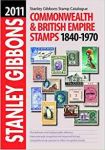Stanley Gibbons Stamp Catalogue Commonwealth & Empire Stamps 1840-1970 2011 by Hugh Jefferies
| Stanley Gibbons Stamp Catalogue Commonwealth & Empire Stamps 1840-1970 2011 by Hugh Jefferies | |
|
| |
| Category: Business and Finance | |
| Reviewer: John Van der Kiste | |
| Summary: The 113th edition of the British Commonwealth catalogue, including Great Britain, covering all issues prior to the introduction of decimal currency in 1971. | |
| Buy? Maybe | Borrow? Yes |
| Pages: 700 | Date: September 2010 |
| Publisher: Stanley Gibbons Ltd | |
| ISBN: 978-0852597972 | |
|
| |
Over the years the 'Gibbons Commonwealth' catalogue has seen many changes. This is the second edition since Gibbons compacted its listings to cover the era of pounds, shillings and pence up to the end of 1970. (This is fair as the currency in Britain and various other territories goes, though Canada and her territories went decimal in the mid-nineteenth century). This boundary is extended in a few instances, such as the Barbuda British monarchs series, issued at regular intervals over an eighteen-month period spanning 1970-1, but by and large this is what we might call the sterling era catalogue.
Up to a point, the basic principles of this volume are the same as the old Commonwealth catalogue that I remember from three or four decades ago. There is a degree of specialization beyond the basic listing of the simplified one, allowing for variations in perforation, watermark, and plain or phosphor-banded where relevant. The main changes I notice are that certain colonies and territories are grouped together, so that the old issues for Tasmania, New South Wales et al and the more recent ones for Christmas Island, Norfolk Island, New Guinea and the like will be found in the same group as Australia; ditto New Brunswick, Newfoundland, Prince Edward Island and Nova Scotia with Canada. Where territories changed their names after independence, they are generally listed according to the name on the stamp, for example Gold Coast which became Ghana in 1957. On the other hand, everything inscribed Eire is still under Ireland. A few countries which we may not immediately think of as old Commonwealth, such as Egypt and Iraq (none of which ever bore the British monarch's head) are also within these pages, which as far as I am aware was not Gibbons policy until very recently.
The introductory pages furnish a wealth of additional information alongside the individual territories' listings with prices and in full colour. A profusely illustrated six-page article, which originally appeared over several issues of the monthly magazine in 2003 on 'The importance of condition', is essential reading for collectors at all levels, emphasizing such details as the importance of imperforate stamps with good margins, and well-centred perforated specimens. I learnt a certain amount from this on which cancellations to seek out or avoid; it is not just a matter of preferring light postmarks to heavy, but also choosing 1960s British issues with circular date stamps, rather than the more commonly seen wavy lines, the latter being worth only a small proportion of catalogue. A further article goes into the minutiae of gum, or the lack of it, through five stages – from unmounted through to 'heavily mounted small part original gum', watermarks and different papers. Some of these factors denote a high degree of specialization and not every collector will get involved to the full extent – or can even afford to – although the guidelines regarding condition are essential study. A two-page bibliography, guiding readers and collectors to studies of individual territories, also looks like a recent innovation.
The preface suggests that prices are still rising, partly through collectors returning to the hobby and partly as continuing low levels of interest rates in savings accounts make purchasing stamps a more worthwhile option. What it does not warn the unwary is that such a form of investment is never dependable, and a collector (or one might say speculator) cannot necessarily expect a worthwhile rate of return on the original outlay if or when he/she decides or needs to sell. Over the years, many people have consulted these catalogues mainly if not wholly for the prices. A quick examination of the British pages suggests that the most expensive item is the unused 1882 £1 brown-lilac (£160,000), while some of the 1840s Mauritius issues are close to the six-figure mark.
However, it is always interesting to look at the changes in stamp design over the years, from the often rather crude specimens of the mid-nineteenth century to the brightly coloured apparitions that were predominant from the mid-1960s onwards. I'm one of the old school who still has a weakness for the older classic designs, particularly of the crown colonies when the monarch's head was enclosed in a crowned oval frame alongside a pictorial design, which might be either in black or else the same colour as the surrounding design. At the risk of mounting a personal hobby horse, compare any Kenya, Uganda and Tanganyika series from 1954 or earlier with the garish fare that followed a decade later. Much the same goes for old (or not so old) Bermuda, British Virgin Islands, or Trinidad and Tobago from similar eras.
These catalogues are admittedly not inexpensive. (In the days when all designs were in black and white, I remember being given the 1965 Commonwealth volume as a Christmas present, and I think it set my parents back thirty shillings, or £1.50 in today's prices). Some might see it as something of an investment in itself. Yet its time-honoured place as the standard work of reference for its subject remains unchallenged.
Our thanks to Stanley Gibbons Ltd for providing Bookbag with a review copy.
For similar reference and reading, see also the reviews of the Great Britain Concise Stamp Catalogue 2010 by Stanley Gibbons, and for an unusual, associated work of fiction, The Stamp King by G. De Beauregard and H. De Gorsse.
Please share on: ![]() Facebook,
Facebook, ![]() Twitter and
Twitter and
![]() Instagram
Instagram
![]() You can read more book reviews or buy Stanley Gibbons Stamp Catalogue Commonwealth & Empire Stamps 1840-1970 2011 by Hugh Jefferies at Amazon.co.uk Amazon currently charges £2.99 for standard delivery for orders under £20, over which delivery is free.
You can read more book reviews or buy Stanley Gibbons Stamp Catalogue Commonwealth & Empire Stamps 1840-1970 2011 by Hugh Jefferies at Amazon.co.uk Amazon currently charges £2.99 for standard delivery for orders under £20, over which delivery is free.
![]() You can read more book reviews or buy Stanley Gibbons Stamp Catalogue Commonwealth & Empire Stamps 1840-1970 2011 by Hugh Jefferies at Amazon.com.
You can read more book reviews or buy Stanley Gibbons Stamp Catalogue Commonwealth & Empire Stamps 1840-1970 2011 by Hugh Jefferies at Amazon.com.
Comments
Like to comment on this review?
Just send us an email and we'll put the best up on the site.


